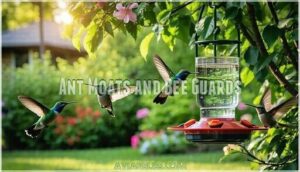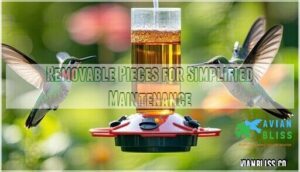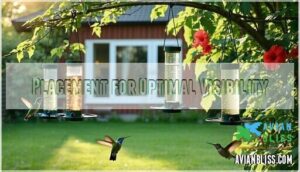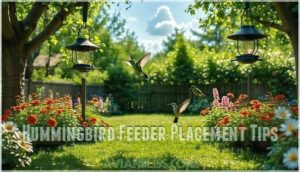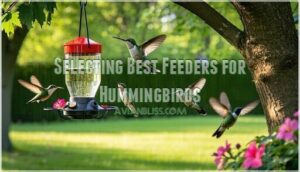This site is supported by our readers. We may earn a commission, at no cost to you, if you purchase through links.
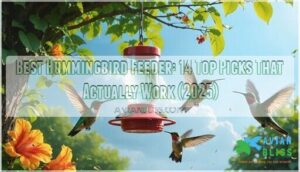
Dish-style feeders work better than bottle types since they’re simpler to maintain and hummingbirds can access nectar more naturally.
Glass beats plastic for durability and cleaning ease.
Look for wide-mouth designs with removable parts – trust me, you’ll thank yourself when cleaning time rolls around.
Ant moats and bee guards keep unwanted visitors away while red colors act like neon signs for hungry hummers.
The secret lies in strategic placement and regular maintenance that turns casual visitors into loyal residents, with features like easy cleaning and ant protection being key to attracting and keeping hummingbirds, and utilizing bright red accents to draw them in.
Table Of Contents
- Key Takeaways
- Choosing Best Hummingbird Feeders
- Hummingbird Feeder Features
- Attracting Hummingbirds Effectively
- Hummingbird Feeder Maintenance
- Top 14 Hummingbird Feeders
- 1. HummZinger HighView Hummingbird Feeder
- 2. Purple Speckled Mushroom Hummingbird Feeder
- 3. Hummingbird Feeder Window or Tree
- 4. Ant Trap for Bird Feeders
- 5. Vintage Hummingbird Feeder 5 Stations
- 6. First Nature Hummingbird Feeder Red 16 Oz
- 7. Window Mount Hummingbird Feeder
- 8. Red Hummingbird Nectar Feeder Choice
- 9. Clear Hummingbird Feeder Best Choice
- 10. Iridescent Hummingbird Window Feeder Mount
- 11. BOLITE Glass Hummingbird Feeder Retro Edison Bulb
- 12. Perky Pet Pinch Waist Glass Hummingbird Feeder
- 13. LUJII Glass Hummingbird Feeder With Ant Moat
- 14. More Birds Glass Mason Jar Hummingbird Feeder
- Hummingbird Feeder Placement Tips
- Year-Round Feeder Care Strategies
- Selecting Best Feeders for Hummingbirds
- Frequently Asked Questions (FAQs)
- What is the best hummingbird feeder?
- Are window hummingbird feeders good?
- What are the different types of hummingbird feeders?
- Where can I buy a hummingbird feeder?
- Are red hummingbird feeders good?
- What size hummingbird feeder do I Need?
- Is it OK to feed hummingbirds sugar water?
- How do I attract hummingbirds to my hummingbird feeder?
- Do hummingbirds prefer red feeders?
- Where is a good place to hang a hummingbird feeder?
- Conclusion
Key Takeaways
- Choose dish-style feeders over bottle types – they’re easier to clean, prevent leaks, and give hummingbirds more natural access to nectar
- Look for easy-cleaning features like wide mouths and removable parts – you’ll need to clean them every 2-3 days in hot weather to prevent dangerous mold and bacteria
- Select feeders with built-in ant moats and bee guards – these keep pests away from your nectar without harmful chemicals while ensuring hummingbirds get uncontaminated food
- Use bright red accents and strategic placement near natural food sources – position feeders 4-6 feet high in partial shade near flowering plants like bee balm or cardinal flower to create an irresistible hummingbird magnet
Choosing Best Hummingbird Feeders
You’ll find three main types of hummingbird feeders to evaluate: dish feeders that prevent leaks and simplify cleaning, bottle feeders that hold more nectar for busy yards, and window feeders that let you watch these tiny acrobats up close.
Glass models resist fading and chemical leaching but cost more, while plastic versions offer lightweight durability at budget-friendly prices.
Dish Feeders Vs Bottle Feeders
Two main feeder designs dominate the hummingbird feeding world, each with distinct advantages for your backyard visitors.
Dish feeders offer hassle-free cleaning with their wide openings and simple two-piece construction, making maintenance a breeze compared to narrow-necked bottle feeders that require special brushes.
The nectar flow in dish designs prevents leaks since ports sit above the reservoir, while bottle types can drip and attract unwanted insects.
Bird preferences lean toward dish feeders’ unobstructed access and comfortable perches, though bottle styles hold more nectar for busy gardens.
Your choice between these feeder types depends on whether you prioritize easy cleaning tips or larger capacity for your nectar feeders.
For ideal results, consider using dish style feeders to attract hummingbirds to your yard.
Glass Feeders Vs Plastic Feeders
Material choice dramatically impacts your feeder’s performance and longevity. Here’s what matters most:
- Feeder Durability: Glass feeders resist chemical leaching and maintain nectar quality longer, while plastic feeders offer shatter-resistance but may degrade over time.
- Breakage Risk: Plastic feeders won’t shatter when dropped, making them safer around children and pets.
- Material Comparison: Glass doesn’t fade or warp in sunlight, whereas plastic can become brittle and discolored.
- Nectar Quality: Glass preserves taste better since it doesn’t absorb odors or flavors like some plastics.
- Feeder Design: Both materials offer excellent options, but glass feeders typically feature more elegant, artistic styling.
The best hummingbird feeder materials depend on your priorities—choose glass for longevity or plastic for peace of mind.
Window Feeders for Close-up View
Window feeders bring hummingbirds within arm’s reach, transforming your glass into a front-row theater seat.
Aspects Window and similar window mounted feeder designs use strong suction cups to create stable feeder mounts for close ups.
You’ll discover intimate bird viewing moments as these tiny acrobats hover just inches away.
Window feeders offer unmatched convenience – no yard space needed, just pure window placement magic.
When selecting a window feeder, consider the importance of weatherproofing materials best window bird feeder to guarantee durability and longevity.
Hummingbird Feeder Features
When choosing a hummingbird feeder, you’ll want features that keep both birds and maintenance hassle-free.
Look for ant moats and bee guards to prevent unwanted visitors, wide-mouth reservoirs that make cleaning simple, and removable pieces that break down for thorough washing, including removable pieces.
Ant Moats and Bee Guards
Protecting your nectar from invading ants and bees requires smart pest control strategies that actually work. Ant moats create water barriers that stop crawling insects dead in their tracks, while bee guards restrict port access to hummingbird-sized beaks only.
Using an ant moat system can be an effective way to keep ants away from hummingbird feeders.
Here’s why these insect traps transform your feeding station:
- Ant moats deliver near 100% effectiveness when properly maintained with water
- Bee repellers prevent nectar contamination and feeder abandonment
- Nectar protection keeps sugar water fresh longer without pest interference
- Built-in barriers reduce cleaning frequency and maintenance hassles
- Dual-protection systems guarantee consistent hummingbird visits year-round
Wide-Mouth Reservoirs for Easy Cleaning
While ant moats keep crawlers out, wide mouth reservoirs make cleaning actually enjoyable instead of a dreaded chore.
Reservoir design with wide openings transforms feeder maintenance from frustrating to fast. You can easily reach every corner without special brushes or awkward angles. Easy refill becomes effortless when you’re not wrestling with narrow necks.
Easy clean feeders with wide openings maintain consistent nectar flow and prevent bacterial buildup that narrow designs can’t reach.
Removable Pieces for Simplified Maintenance
The best easy clean feeders break apart completely for hummingbird feeder maintenance.
You’ll twist off ports, unscrew bases, and remove ant moats in seconds. These detachable components prevent stubborn buildup while ensuring proper nectar flow and leak prevention.
Smart feeder design means no more wrestling with bottle brushes—every surface becomes accessible for thorough washing, keeping your feeders sparkling clean.
Bees are often attracted to feeders due to the appealing sugar water.
Attracting Hummingbirds Effectively
You’ll attract more hummingbirds by placing feeders in visible spots with red accents and positioning them near natural nectar sources like trumpet vines or bee balm.
The combination of strategic placement, bright red coloring, and companion plantings creates an irresistible hummingbird magnet that’ll have these tiny acrobats visiting your yard all season long, making it a perfect example of a hummingbird magnet.
Placement for Optimal Visibility
Strategic feeder placement transforms your yard into a hummingbird haven that’ll have these aerial gems returning daily.
Position hummingbird feeders where human view meets bird safety—typically 5-6 feet high in partially shaded spots. Sunlight exposure should be limited to morning hours, while wind protection prevents nectar spills.
Multiple feeders spaced 10-15 feet apart reduce territorial squabbles.
- Predator avoidance: Mount feeders away from cat hiding spots and dense shrubs
- Garden feeders work best near red flowers or natural nectar sources
- Bird watching becomes effortless when feeders sit within 10 feet of windows
Use of Red Color for Attraction
Looking beyond placement, hummingbirds possess remarkable visual cues that make red color preference a game-changer for attraction.
These tiny aerial acrobats evolved heightened sensitivity to red wavelengths, creating an evolutionary love affair with crimson blooms.
Your hummingbird feeders should feature red accents or bases—never red dye in nectar, which poses health risks.
Color theory explains why red stands out against green foliage, while hummingbird vision detects these vibrant signals from impressive distances.
Skip artificial red dye completely; natural nectar stays clear while red feeder components provide all the red attraction power you need.
Understanding the visual perception process is key to effectively attracting hummingbirds to your feeders.
Companion Plants for Hummingbirds
Beyond the bright red of hummingbird feeders, you’ll create an irresistible paradise by adding Nectar Flowers that complement your setup perfectly. Strategic Flower Choices like trumpet vine and cardinal flower transform your space into a thriving Bird Garden ecosystem.
- Native Plants like bee balm and salvia provide reliable Pollen Sources throughout growing seasons
- Layer different bloom times from spring cardinal flower to fall-blooming sage for continuous nectar
- Position tall sunflowers near hummingbird feeders to create natural perching spots for territorial birds
Hummingbird Feeder Maintenance
You’ll need to clean your hummingbird feeder at least once a week to prevent dangerous mold and bacteria that can harm visiting birds.
Hot weather requires cleaning every 3-5 days since nectar spoils faster, and you should replace the sugar water completely each time to keep your feathered friends healthy.
Cleaning Schedule for Feeders
During hot summer months, you’ll need feeder sanitizing every 2-3 days to prevent bacteria buildup.
Clean feeders weekly in cooler weather using bottle brushes and vinegar solutions. Your refill schedules should match cleaning frequency – fresh nectar with thorough feeder cleaning prevents contamination.
Keep cleaning tools handy: bottle brushes reach narrow ports while soaking removes stubborn residue. Following this feeder cleaning schedule guarantees your hummingbirds stay healthy and happy.
Preventing Mold and Bacteria Growth
Mold and bacteria thrive in sugar water solution, turning your sweet nectar into a health hazard for hummingbirds.
Clean feeders regularly—dirty nectar kills hummingbirds faster than an empty feeder.
Nectar spoilage occurs rapidly in warm conditions, making bacteria control your top priority.
Place feeders in shade to slow spoilage and establish consistent cleaning schedules.
Use hot, soapy water for thorough feeder sanitizing, scrubbing ports with small brushes.
Mold prevention requires complete drying before refilling—moisture creates perfect breeding grounds for harmful microorganisms that can seriously harm your feathered visitors.
Regularly checking hummingbird feeders is essential for maintaining a safe environment.
Refilling and Replacing Nectar
Fresh hummingbird nectar keeps your feeder visitors coming back for more. Your refill schedules depend on temperature, sunlight exposure, and feeder capacity—hot weather demands fresh nectar every 2-3 days while cooler conditions extend this to 4-5 days.
Follow these essential sugar ratios for perfect nectar recipes:
- Classic formula: 1 part white sugar to 4 parts water—never honey or artificial sweeteners
- Temperature monitoring: Replace more frequently during heat waves to prevent nectar spoilage
- Capacity planning: Smaller feeders need more frequent refilling but waste less nectar
Your feeder cleaning guide starts with emptying old nectar completely before adding fresh batches. Sugar water feeders work best when you maintain consistent schedules, keeping your tiny aerial acrobats healthy and satisfied.
Top 14 Hummingbird Feeders
You’ll find the perfect hummingbird feeder among these 14 carefully selected options that combine proven attractiveness with practical maintenance features.
Each feeder has been chosen for its ability to draw hummingbirds consistently while offering easy cleaning and reliable durability.
1. HummZinger HighView Hummingbird Feeder
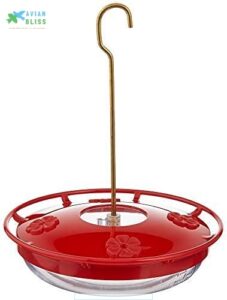
With its elevated HighView perch, this feeder transforms your backyard into a hummingbird sanctuary where birds can rest while they dine.
You’ll get unobstructed views of every feeding session, perfect for photography without wing blur.
The unbreakable polycarbonate construction withstands weather extremes, while four feeding ports accommodate multiple visitors simultaneously.
Its bright red cover acts like a beacon, drawing hummingbirds from remarkable distances.
What sets this feeder apart is its built-in ant moat—no more watching ants march toward your nectar supply.
The leak-proof design eliminates sticky messes, and you can mount it on a post or hang it wherever suits your yard best.
With a lifetime guarantee backing this investment, it’s reliability you can count on season after season.
Best For: Backyard bird enthusiasts who want a durable, easy-to-maintain feeder that attracts hummingbirds while preventing ant contamination and providing excellent viewing opportunities.
- Limited to four feeding ports, which may not accommodate large flocks of hummingbirds during peak migration periods
- Post-mounting requires purchasing a separate 5/8-inch dowel or 1/2-inch pole for installation
- Higher price point compared to basic plastic feeders without advanced features like ant moats and perches
- Built-in ant moat and leak-proof design eliminate common feeding problems like insect contamination and sticky messes
- Elevated HighView perch allows hummingbirds to rest while feeding, creating better photography opportunities and extended viewing sessions
- Unbreakable polycarbonate construction with lifetime guarantee ensures long-term durability and weather resistance
2. Purple Speckled Mushroom Hummingbird Feeder
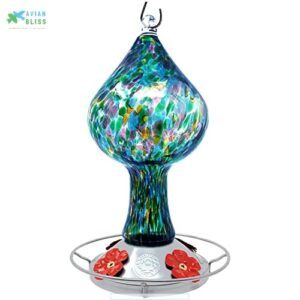
When you’re seeking both beauty and functionality in your yard, the Purple Speckled Mushroom Hummingbird Feeder delivers as a stunning conversation piece.
This hand-blown glass masterpiece holds up to 26 ounces of nectar, reducing your refill frequency while attracting multiple birds with its four dedicated feeding ports and perches.
You’ll appreciate the wide-mouth design that makes cleaning effortless, while the leak-proof construction with rubber seals prevents messy drips.
The deep purple speckled pattern won’t fade over time, ensuring your garden maintains its artistic flair season after season.
With metal feeding ports that deter larger birds and wasps, this feeder combines practical pest management with undeniable visual appeal that transforms any outdoor space.
Best For: Garden enthusiasts who want an artistic hummingbird feeder that serves as both functional bird feeding station and decorative outdoor art piece.
- Hand-blown glass construction makes it more fragile and expensive than standard plastic feeders
- Requires vigilant cleaning to prevent mold buildup, especially around decorative ledges and rubber seals
- Some components like flowers may rust or break over time, potentially requiring replacement parts
- Large 26-ounce capacity with four feeding ports accommodates multiple birds while reducing refill frequency
- Hand-blown glass construction with fade-resistant purple speckled design creates stunning garden focal point
- Wide-mouth opening and detachable components make cleaning and maintenance simple and thorough
3. Hummingbird Feeder Window or Tree

Flexibility stands out with this innovative feeder that adapts to your space—mount it directly on windows with suction cups or hang it from trees using the traditional chain.
You’ll get acrylic construction that withstands weather while the built-in ant moat keeps pests away from your nectar.
The removable lid makes filling simple, and bee guards prevent unwanted visitors from stealing the sweet treat.
Multiple hanging options mean you can place it where hummingbirds feel safest—whether that’s your kitchen window for morning coffee entertainment or tucked under tree branches for natural cover.
Just remember to apply water to those suction cups properly for secure attachment.
Best For: Homeowners who want flexible feeder placement options and enjoy watching hummingbirds up close from their windows or in natural tree settings.
- Suction cups require proper installation and may fail on uneven surfaces
- Some components like the lid and perch can be brittle and break with rough handling
- Chain may rust over time and ant moat can attract other flying insects if not maintained
- Dual mounting system offers versatility—suction cups for windows or chains for trees
- Weather-resistant acrylic construction with built-in ant moat keeps pests away
- Easy maintenance with removable lid and included cleaning accessories
4. Ant Trap for Bird Feeders
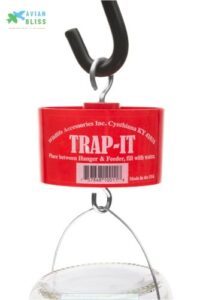
Without proper protection, ants can turn your hummingbird feeder into their personal buffet, leaving nothing but frustration behind.
The Trap-It ant moat solves this problem with a simple yet brilliant design that’s been stopping ant invasions since 1989.
This ingenious water barrier requires just 6 oz of water to create an impassable moat above your feeder. You’ll hang it using an "S" hook, attach your feeder below, and watch as ants hit their watery roadblock.
The engineering is straightforward but effective—ants can’t swim across to reach your sweet nectar.
Place it in shaded areas to reduce evaporation, and consider adding cooking oil to extend water life.
Some users find the price steep, but it’s a worthwhile investment that protects your nectar and enhances hummingbird enjoyment for years.
Best For: Hummingbird enthusiasts who want a reliable, long-term solution to keep ants away from their feeders without harmful chemicals.
- Requires regular water refilling, especially in hot weather when evaporation happens quickly
- Higher upfront cost compared to DIY solutions or basic ant deterrent methods
- Water can attract mosquitoes if not changed every 2-3 days during maintenance
- Simple water barrier design that’s been proven effective since 1989 with minimal maintenance required
- Works with existing feeders and includes built-in hooks for easy installation on any hanging setup
- Durable outdoor construction that provides years of ant protection while allowing birds to use the moat water
5. Vintage Hummingbird Feeder 5 Stations
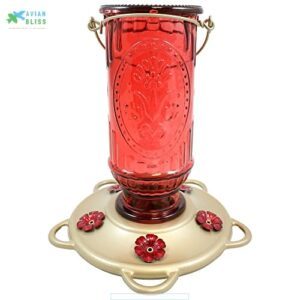
You’ll love this vintage-style feeder’s old-world charm combined with serious functionality.
The red glass bottle naturally attracts hummingbirds while five flower-shaped feeding ports accommodate multiple visitors simultaneously.
Its 20-ounce capacity means fewer refills, and the brushed gold base adds durability without sacrificing aesthetic appeal.
Hand washing keeps it pristine, and the wide mouth makes filling a breeze—it’s basically a hummingbird café with vintage flair.
Best For: Bird enthusiasts who want a durable, attractive feeder that can handle multiple hummingbirds while adding vintage charm to their garden.
- Five feeding stations allow multiple hummingbirds to feed simultaneously without competition
- Durable glass and metal construction withstands weather and lasts for years
- Large 20-ounce capacity reduces the frequency of refills
- Hand-wash only requirement makes cleaning more time-consuming than dishwasher-safe alternatives
- Red coating on glass may chip or wear off with repeated washing over time
- Large bottle can obstruct view of birds feeding at certain ports
6. First Nature Hummingbird Feeder Red 16 Oz
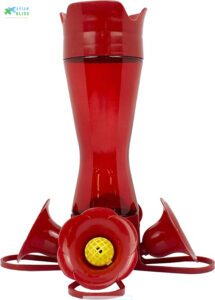
The First Nature’s red plastic construction attracts hummingbirds instantly while standing up to outdoor weather year after year.
You’ll appreciate the 16-ounce capacity that cuts down refill trips and the ten feeding ports that accommodate multiple birds without crowding.
The wide-mouth opening lets you fill and clean without funnels or frustration, while the circular perch gives tired wings a perfect resting spot.
Though some users notice occasional fading after prolonged sun exposure, this affordable American-made feeder consistently delivers reliable performance that keeps your backyard buzzing with activity.
Best For: Budget-conscious bird enthusiasts who want a reliable, easy-to-maintain feeder that attracts multiple hummingbirds without frequent refilling.
- Red plastic material may fade after prolonged sun exposure, requiring replacement every 2-3 years
- Hand-wash only requirement means no dishwasher convenience for busy users
- Some users report occasional minor leaking issues that can attract ants
- Large 16-ounce capacity with ten feeding ports reduces refill frequency and accommodates multiple birds simultaneously
- Wide-mouth opening and twist-apart base make filling and thorough cleaning simple without special tools
- Durable American-made construction with competitive pricing under $12 offers excellent long-term value
7. Window Mount Hummingbird Feeder

Window mount hummingbird feeders transform your glass into a front-row seat for nature’s tiniest aerial performers.
These compact feeders stick directly to your window using industrial-strength suction cups, bringing hummingbirds within inches of your face for unmatched viewing pleasure. You’ll witness every iridescent feather detail as these remarkable birds hover and feed just beyond the glass.
Most window feeders hold 8-27 ounces of nectar with 2-3 feeding ports, accommodating multiple visitors simultaneously.
They’re perfect for apartments or limited outdoor spaces, completely disassemble for easy cleaning, and actually reduce window strikes by making glass more visible to birds, providing an unmatched viewing pleasure with industrial-strength suction cups, and bringing hummingbirds within inches of your face, which is a front-row seat.
Best For: Window watchers who want to observe hummingbirds up close from inside their home, especially those with limited outdoor space or living in apartments.
- Provides unmatched close-up viewing of hummingbirds feeding just inches from your window
- Industrial-strength suction cups ensure secure attachment without frequent falls
- Actually helps prevent bird-window collisions by making glass more visible to birds
- Limited nectar capacity (8-27 oz) requires more frequent refilling than larger feeders
- Suction cups may occasionally fail in extreme weather conditions
- Attracts fewer birds overall compared to traditional hanging feeders due to smaller size
8. Red Hummingbird Nectar Feeder Choice
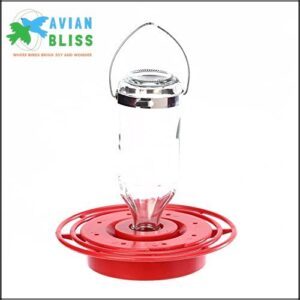
Bursting with brilliant red color, this 8-ounce polycarbonate feeder draws hummingbirds like a magnet.
You’ll love watching multiple birds perch comfortably at its eight nectar ports while the brass hangers resist rust through every storm.
It handles 30 mph winds without spilling a drop and breaks down easily for cleaning every few days.
Both Anna’s and Rufous hummingbirds can’t resist this durable feeder that makes maintenance a breeze.
Best For: Serious hummingbird enthusiasts who want a durable, multi-port feeder that attracts multiple species while withstanding harsh weather conditions.
- Brilliant red color and 8 feeding ports effectively attract both small and large hummingbird species like Anna’s and Rufous
- Weather-resistant construction with brass hangers handles winds up to 30 mph without leaking or rusting
- Easy maintenance with glass nectar container that breaks down for simple cleaning every 3-4 days
- Hummingbirds may show initial hesitation before adapting to the feeder design
- Requires daily gentle shaking to ensure proper nectar flow from reservoir to ports
- 8-ounce capacity may need frequent refilling in areas with high hummingbird activity
9. Clear Hummingbird Feeder Best Choice
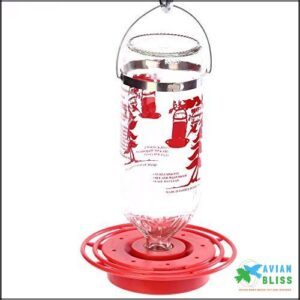
With its crystal-clear 32-oz capacity and 8 feeding ports, this transparent feeder transforms hummingbird watching into an art form.
You’ll instantly spot nectar levels through the clear reservoir design, preventing those awkward empty-feeder moments that leave hungry birds disappointed.
The high-impact polycarbonate construction resists weather extremes while maintaining perfect visibility.
Built-in brass hangers provide reliable suspension, and the red base acts like a beacon for territorial hummers.
Here’s the real magic: you can watch hummingbird tongues dart in and out at lightning speed—up to 12 times per second!
The wide-mouth design simplifies refilling, though you’ll want a funnel for mess-free pouring.
Clean weekly with warm, soapy water to prevent mold buildup.
This bird watcher’s dream delivers unobstructed views of feeding behavior while keeping nectar fresh and accessible.
Best For: Bird enthusiasts who want unobstructed views of hummingbird feeding behavior while easily monitoring nectar levels and maintaining feeder cleanliness.
- Wire holder components may rust quickly when exposed to outdoor elements
- Narrow neck design can make thorough cleaning challenging despite wide-mouth feature
- Flat red plastic base attracts unwanted bees and insects along with hummingbirds
- Crystal-clear visibility allows real-time observation of feeding patterns and nectar level monitoring
- Durable high-impact polycarbonate construction with reliable brass hangers withstands weather extremes
- Wide-mouth design with 8 feeding ports accommodates multiple birds and simplifies refilling process
10. Iridescent Hummingbird Window Feeder Mount

Perched atop your window glass, this iridescent feeder transforms ordinary birdwatching into an intimate wildlife theater.
The 8 oz capacity paired with three hollyhock-inspired feeding ports mimics nature’s own design, drawing hummingbirds within arm’s reach of your living space.
Its shatter-resistant construction features soft, flexible ports with cleverly tapered stems that welcome hummers while keeping bees locked out.
The suction cup mounting system delivers rock-solid adhesion, while quick-release clips make maintenance surprisingly painless.
You’ll need to swap nectar daily and handle those delicate plastic prongs like fine china—they’re the feeder’s Achilles’ heel.
Though UV rays will eventually fade the acrylic finish, proper placement in partial shade extends its lifespan considerably.
This feeder brings nature’s aerial acrobats right to your fingertips.
Best For: Homeowners and apartment dwellers who want an up-close hummingbird viewing experience directly from their windows without yard space for traditional feeders.
- Plastic feeding ports are fragile and prone to breaking over time
- Requires daily nectar changes and frequent cleaning (1-2 times weekly)
- UV exposure gradually degrades plastic components over 4-6 years despite protective measures
- Provides intimate, close-up hummingbird observation through transparent design and window mounting
- Features bee-resistant tapered stems and quick-release clips for easy maintenance
- Strong suction cup system holds securely even in windy conditions
11. BOLITE Glass Hummingbird Feeder Retro Edison Bulb

You’ll fall in love with the BOLITE Glass Hummingbird Feeder’s vintage Edison bulb design that transforms your garden into a charming retreat.
This hand-blown glass masterpiece holds 20-25 oz of nectar and features five flower-shaped red feeding ports with comfortable perches.
The thick, stained glass construction weighs 2.44 pounds empty, providing stability against wind while withstanding seasonal weather changes.
You’ll appreciate the leakproof two-piece base that separates easily for thorough cleaning and quick refills.
The wide-mouth design lets you scrub every corner with a bottle brush, preventing mold buildup.
While the vibrant colors may fade slightly over time, the durable glass maintains its integrity and functionality, making this feeder a reliable choice for attracting multiple hummingbirds.
Best For: Gardening enthusiasts who want an attractive, high-capacity hummingbird feeder that combines vintage aesthetics with reliable functionality and easy maintenance.
- Heavy weight (2.44 lbs empty, over 2.5 lbs filled) requires sturdy mounting points and may not work on thin branches
- Vibrant glass colors, especially red, may fade over time with sun exposure and repeated washing
- Lacks built-in ant moat or bee guards that some competing feeders include for insect deterrence
- Generous 20-25 oz capacity with leakproof design reduces refilling frequency and prevents messy spills
- Hand-blown glass construction with vintage Edison bulb styling adds decorative appeal to any garden setting
- Easy-clean two-piece design with wide mouth allows thorough maintenance to prevent mold and nectar spoilage
12. Perky Pet Pinch Waist Glass Hummingbird Feeder
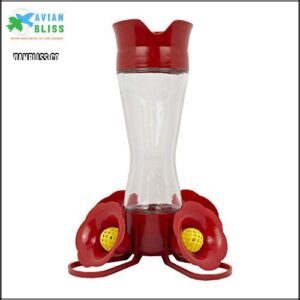
Although it’s been around for decades, the Perky-Pet Pinch-Waist Glass Hummingbird Feeder remains a backyard favorite for good reason.
This classic 8-ounce design features four flower-shaped feeding ports with comfortable perches, giving your feathered friends a perfect pit stop during their busy day.
The wide-mouth glass bottle makes filling and cleaning surprisingly simple – no more wrestling with narrow openings or struggling to scrub away stubborn residue.
You’ll appreciate the built-in bee guards and ant moat that keep pests at bay, while the clear glass lets you monitor nectar levels at a glance.
Made in the USA.
Best For: Bird enthusiasts who want a reliable, easy-to-maintain hummingbird feeder with effective pest deterrence and a proven track record of attracting multiple birds.
- Wide-mouth glass design makes filling and cleaning significantly easier than narrow-neck alternatives
- Built-in bee guards and ant moat effectively prevent insect contamination while keeping nectar fresh for hummingbirds
- Four feeding ports with perches accommodate multiple birds simultaneously and consistently attract high visit rates
- Frequent leakage issues at base and feeding ports reported by users despite proper assembly
- Plastic components (base, bee guards) prone to cracking with regular cleaning and lack replacement part availability
- Design changes from original small-neck version can lead to accidental spills during filling
13. LUJII Glass Hummingbird Feeder With Ant Moat
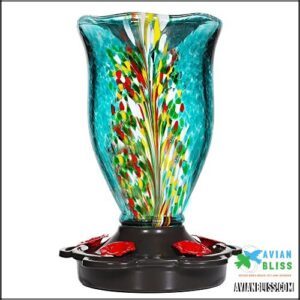
With its built-in ant moat and rustproof metal base, the LUJII Glass Hummingbird Feeder delivers both beauty and brains.
This hand-blown glass masterpiece holds 36oz of nectar while featuring 5 decorative metal flower feeding ports that accommodate multiple hummingbirds simultaneously.
You’ll appreciate its wide-mouth opening for effortless cleaning and the thick glass construction that prevents fading and cracking.
The integrated ant moat keeps crawling pests away when filled with water, though you’ll need to refill it regularly in hot weather.
Users consistently report increased hummingbird activity after switching to this feeder, with some seeing feeders emptied within three days during peak season.
Best For: Bird enthusiasts who want a beautiful, functional hummingbird feeder that doubles as garden art and can handle high traffic during peak feeding seasons.
- Ant moat requires regular water refills, especially in hot climates where evaporation is rapid
- Higher price point compared to basic plastic feeders, though reasonable for glass alternatives
- Glass construction makes it heavier and potentially more fragile than lightweight plastic options
- Hand-blown glass construction with vibrant, fade-resistant colors that enhance garden aesthetics
- Built-in ant moat and 5 metal feeding ports accommodate multiple hummingbirds while deterring pests
- Large 36oz capacity reduces refill frequency and wide-mouth design makes cleaning effortless
14. More Birds Glass Mason Jar Hummingbird Feeder
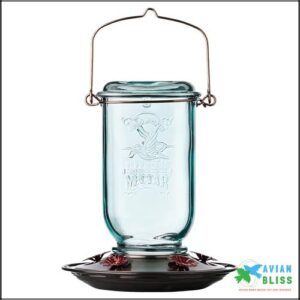
Nostalgia meets functionality in the More Birds Glass Mason Jar Hummingbird Feeder. This vintage-inspired beauty combines a 25-ounce aqua-tinted glass reservoir with brushed bronze accents, creating an antique charm that’ll make your garden guests do a double-take.
Five polished red metal flower ports provide multiple feeding stations, while the wrap-around perch ring lets hummingbirds rest comfortably during their nectar breaks. You’ll love the wide-mouth opening that makes filling spill-free and cleaning effortless—no bottle brush wrestling required.
The durable glass and metal construction outlasts plastic alternatives, though you’ll want to hand-wash it to prevent rust on those metal components. Customer reviews consistently rate this feeder 4.2 out of 5 stars, with many noting it empties fastest among multiple feeders—proof that hummingbirds can’t resist its old-school appeal.
Best For: Garden enthusiasts who want a durable, aesthetically pleasing feeder that attracts multiple hummingbirds while adding vintage charm to their outdoor space.
- Metal components may develop rust over time, especially in wet climates, requiring regular inspection and maintenance
- Heavier than plastic feeders, making it more challenging to move or reposition frequently
- Higher price point compared to basic plastic alternatives, though quality justifies the investment
- Vintage mason jar design with aqua-tinted glass and brushed bronze finish creates attractive focal point in any garden setting
- Large 25-ounce capacity with five feeding ports supports multiple hummingbirds and reduces refilling frequency
- Durable glass and metal construction outlasts plastic alternatives and resists weather damage better than cheaper options
Hummingbird Feeder Placement Tips
You’ll dramatically increase your hummingbird visitors by choosing the right feeder placement over simply buying the fanciest model.
Strategic positioning considering height, safety, and natural food sources transforms any decent feeder into a hummingbird magnet.
Optimal Height and Visibility
Position your hummingbird feeders at eye level—about 4-6 feet high—for ideal bird visibility and viewing angles.
This height adjustment creates perfect feeder placement while allowing clear flight paths for visiting birds.
Window feeders work brilliantly at this level, letting you watch feeding behaviors up close.
Choose spots with sunlight exposure in the morning but afternoon shade to prevent nectar spoilage.
Hanging feeders and outdoor feeders perform best when you can easily monitor activity from your favorite bird watching spot.
Protection From Predators and Competitive Birds
Beyond height considerations, your feeder shields need strategic placement to outsmart sneaky predators.
Position feeders at least 4ft off the ground with bee proof feeders featuring narrow ports that exclude larger competitive birds.
Install ant moat feeders with water-filled barriers, while squirrel resistance requires pole baffles or wire cages.
Smart territorial behavior management means spacing multiple feeders 15ft apart to reduce conflicts and provide escape routes near dense shrubs.
Proximity to Natural Food Sources
Surrounded by nature’s candy store, your hummingbird feeders work like magnets when positioned near natural nectar sources. Smart feeder distance creates a seamless dining experience that transforms casual visitors into regular customers.
Your yard layout should weave together artificial and natural food sources into one irresistible buffet. Tree proximity matters—place feeders within 10-15 feet of flowering plants to create natural landing strips that guide tiny birds to your sugar water feeders.
- Flower placement strategy: Position trumpet vines, bee balm, and cardinal flowers as "appetizers" that lead directly to your main nectar station
- Garden design integration: Create nectar corridors using salvias and fuchsias that naturally funnel birds toward your hummingbird feeders
- Bird feeder placement zones: Establish multiple feeding areas near different flowering plants to reduce territorial disputes and maximize hummingbird attraction
This coordinated approach turns your entire yard into a hummingbird paradise where artificial and natural nectar sources complement each other perfectly.
Year-Round Feeder Care Strategies
Successful year-round hummingbird feeding requires adapting your care routine to match seasonal migration patterns and weather changes.
You’ll need to adjust nectar concentration, cleaning frequency, and feeder protection based on temperature fluctuations and bird activity levels throughout the year, which involves understanding and responding to these changes.
Seasonal Feeding Patterns for Hummingbirds
Now that you’ve positioned your feeders, understanding hummingbird migration patterns transforms your feeding strategy.
These tiny dynamos experience hyperphagia before migration, doubling their daily intake to build fat reserves for 500+ mile flights.
Peak feeding frenzy hits during late summer when natural flowers decline.
You’ll witness territorial battles ease as males focus on fueling up rather than defending territory.
Here’s what to expect throughout the year:
| Season | Feeding Intensity | Migration Activity |
|---|---|---|
| Spring | High (territory establishment) | Northbound arrival |
| Summer | Moderate (nesting focus) | Preparation begins |
| Fall | Extreme (hyperphagia) | Southbound departure |
Your hummingbird feeders become lifelines during these seasonal shifts.
Body weight increases 25-40% as birds prepare for nonstop journeys.
Feeding schedules shift dramatically—dawn and dusk become prime time as hummingbird feeding habits intensify before departure.
This preparation is crucial for their nonstop journeys and seasonal shifts.
The hummingbirds’ ability to double their daily intake is a result of hyperphagia, which is essential for building fat reserves.
Understanding these patterns can help you create an effective feeding strategy, making your feeders a vital source of energy for these birds during their migration patterns.
Nectar Recipe and Preparation
Creating perfect hummingbird nectar starts with the right sugar ratio—one part white cane sugar to four parts water. This simple nectar recipe beats any store-bought mix and costs pennies per batch.
Here’s your foolproof nectar mix process:
- Boil water first to eliminate bacteria and impurities
- Add sugar while water’s still hot for complete dissolution
- Skip red dye—it’s unnecessary and potentially harmful
- Cool completely before filling feeders to prevent cracking
- Store extra sugar water in your refrigerator for up to two weeks
Your hummingbird food should be crystal clear when finished. Never substitute honey, brown sugar, or artificial sweeteners—they can harm these tiny birds. This basic hummingbird diet staple keeps your visitors healthy and coming back for more delicious homemade nectar.
Preventing Spoilage and Maintaining Feeders
You’ll want to stay ahead of spoilage control to keep your feathered friends healthy.
Change nectar every 2-3 days in hot weather (above 70°F) or weekly in cooler temperatures.
Mold prevention starts with proper feeder sanitizing—use hot water, mild dish soap, and a bottle brush for thorough cleaning.
Your feeder cleaning schedule should include disassembling all removable parts and scrubbing feeding ports where bacteria love to hide.
Cleaning tips for busy bird lovers: rotate two feeders so one’s always available while you’re washing the other.
Don’t forget ant moats filled with water to block sugar-loving invaders.
Following these feeder maintenance tips guarantees nectar freshness and prevents dangerous fermentation that can harm hummingbirds.
Selecting Best Feeders for Hummingbirds
Choosing the right hummingbird feeder involves balancing three key factors that directly impact your success in attracting these tiny visitors.
You’ll want to prioritize feeders with easy-clean designs, durable materials like glass or high-quality plastic, and features that naturally draw hummingbirds while keeping pests away.
This will help ensure that your feeder is both durable and effective at attracting hummingbirds.
Considerations for Attracting Hummingbirds
Anyone can master attracting hummingbirds by focusing on three essential elements that directly impact bird behavior and hummingbird health:
- Feeder Placement – Position hummingbird feeders at eye level in partially shaded spots, away from predators and windows
- Nectar Quality – Mix one part white sugar with four parts water for ideal hummingbird nectar
- Bird Feeder Design – Choose bright red hummingbird feeders with multiple ports to accommodate natural feeding strategies and territorial hummingbird behavior
Understanding hummingbird feeder options is vital for creating an attractive environment.
Importance of Easy Cleaning
Beyond the initial appeal of attracting hummingbirds, easy cleaning determines your feeder’s long-term success.
You’ll discover that feeder design directly impacts maintenance hacks and nectar flow quality.
| Cleaning Challenge | Smart Solution |
|---|---|
| Hard-to-reach ports | Wide-mouth hummingbird feeder designs |
| Stubborn mold buildup | Removable feeding components |
| Time-consuming scrubbing | Dishwasher-safe materials |
| Frequent disassembly | Two-piece construction |
| Refill ease struggles | Saucer-style openings |
Look for feeder cleaning tips that emphasize simple assembly.
Bird feeder maintenance becomes effortless when ports pop out for thorough washing.
This feeder cleaning guide prevents dangerous mold that threatens hummingbird health while ensuring consistent cleaning tips success.
Material Selection for Durability
Smart material choices set you apart from casual bird watchers who replace feeders yearly.
Glass feeder options resist UV-induced fading and don’t crack under temperature swings, making them ideal for serious hummingbird enthusiasts. Plastic feeder models using polycarbonate offer lightweight convenience without compromising feeder durability. Metal alternatives provide rust-resistant style, while recycled materials create sustainable choices that last multiple seasons.
Consider these hummingbird feeder materials for superior performance:
- Glass feeders that maintain crystal clarity through harsh summers
- BPA-free polycarbonate combining plastic’s convenience with glass-like durability
- Stainless steel components that won’t corrode or leach toxins
- UV-stable plastics preventing brittleness and discoloration over time
- Recycled poly lumber offering eco-friendly weather resistance
When selecting a feeder, understanding unique feeder designs can help you choose the best option for your needs.
Frequently Asked Questions (FAQs)
What is the best hummingbird feeder?
Picture ruby-red nectar glistening in morning sunlight—you’ll want the Aspects HummZinger HighView.
Its dish design prevents leaks, includes an ant moat, and offers lifetime durability that’ll keep your feathered friends happy.
Are window hummingbird feeders good?
Window hummingbird feeders offer intimate viewing from indoors and create relaxing experiences.
They’re convenient for cleaning and refilling, though you’ll need patience since birds must adjust to the close proximity before regular feeding begins, which can be a convenient aspect of their design.
What are the different types of hummingbird feeders?
Like Sarah who discovered multiple hummingbird types visiting her yard, you’ve got several feeder options.
Bottle feeders hold more nectar, saucer-style dishes resist leaks, glass models offer durability, and window feeders provide close viewing experiences, including close viewing of the birds.
Where can I buy a hummingbird feeder?
You can buy hummingbird feeders at garden centers, home improvement stores like Home Depot, pet stores, online retailers like Amazon, or specialty bird supply shops for the best selection.
Are red hummingbird feeders good?
The early bird catches the worm – red feeders work brilliantly.
You’ll attract hummingbirds effectively since they’re naturally drawn to bright red colors, making your feeder a beacon for these tiny aerial acrobats.
What size hummingbird feeder do I Need?
You’ll need 8-16 ounces for most yards. Smaller feeders prevent waste since nectar spoils within a week. If you’ve got hummingbird highways buzzing through, consider multiple small feeders instead.
Is it OK to feed hummingbirds sugar water?
While you’d think artificial sweeteners would be healthier, hummingbirds actually thrive on simple sugar water made from white cane or beet sugar. You’re providing them exactly what they need naturally!
How do I attract hummingbirds to my hummingbird feeder?
Place your feeder in partial shade near flowering plants or red decorations. Use multiple smaller feeders to reduce territorial squabbles. Keep nectar fresh and clean weekly to maintain their trust.
Do hummingbirds prefer red feeders?
Hummingbirds aren’t specifically drawn to red feeders themselves, but they’re naturally attracted to bright red colors.
Red nectar or feeder parts catch their attention from distances, making your feeder more visible and appealing to these tiny aerial acrobats, with red being a key attractant.
Where is a good place to hang a hummingbird feeder?
Like finding the perfect perch for a bird’s song, your feeder’s location determines its success.
Hang it at eye level in partially shaded areas away from predators, near natural pollen sources or red yard accents for maximum hummingbird attraction.
Conclusion
Studies show hummingbirds visit feeders every 10-15 minutes during peak season, making feeder reliability essential.
You’ll attract more birds by choosing the best hummingbird feeder with easy-clean features and ant protection.
Glass dish-style models with wide mouths and removable parts simplify maintenance while red accents draw visitors.
Strategic placement near natural food sources, combined with regular cleaning every three days, transforms your yard into a hummingbird haven that’ll keep these tiny jewels returning season after season.
- https://www.anthony-lujan.com/blog/glass-vs-plastic-hummingbird-feeders-which-is-better
- https://www.bobvila.com/articles/best-hummingbird-feeders/
- https://www.birdfy.com/blogs/blogs/how-to-choose-the-best-hummingbird-feeder
- https://www.gardenexperiments.com/best-hummingbird-feeder-review-of-four-types/
- https://www.perkypet.com/articles/how-to-clean-a-hummingbird-feeder

